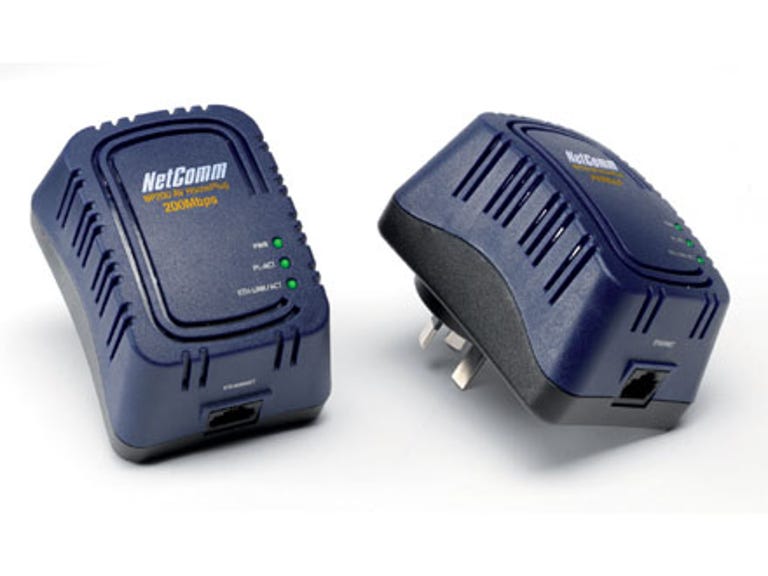 Why You Can Trust CNET
Why You Can Trust CNET NetComm NP200AV Homeplug review: Netcomm NP200AV Homeplug
Netcomm's chunky purple NP200AV Homeplugs offer those stricken with wireless data woes a way out — at a price.
Design
The basic design of Netcomm's Homeplugs hasn't changed markedly over time. Buying a double pack of them — and outside of the wireless NP290W, it's always made more sense to initially purchase double packs — always entailed ending up with two big chunky plugs with 10/100 ethernet ports more or less drilled into the bottom of them. There has been some evolution of the design — the NP200AV plugs have a whole lot more ridges on the sides and front, although we're not sure if they're intended for cooling or just aesthetics. Given that they don't actually open the plug up in any way, our bet is on aesthetics. The other major difference between the NP200AV and its ancestors is that the plugs themselves aren't entirely black; they're a two-tone purple and black instead.
The Good
The Bad
The Bottom Line
Features
The big selling point of the NP200AV is the ability to deliver networking through home or office powerlines, simply by plugging one end near a router (or other network source) and
the other end wherever you need your network port. In the NP200AV's case, the claimed speed is the real selling point; Netcomm claims data rates of up to 200Mbps for the 200AVs, making them suitable at last for real-time high definition video streaming.
There is one caveat to note for existing Homeplug users. Whereas the previous Netcomm Homeplugs offered backwards compatibility between the faster 85Mbps models and the pokier original 14Mbps plugs, the NP200AV's aren't cross-compatible at all. It is possible to run a 200MBps and split 85/14Mbps Homeplug networks in parallel, however.
The other appealing factor about Homeplug technology is that, unlike a lot of networking technology, it's very binary. You plug it in, it lights up, and if it works, it will work. If it doesn't, there's nothing to do but try a different plug port. There's scant configuration to do (unless you wish to turn encryption on, for nervous apartment dwellers), no wireless bandwidth to fight for, and, it's claimed there are no longer problems with power over different phases or from long distances away. The NP200AV have a claimed range of 200 metres, which should cover all but the most ample of residences.
Performance
One factor that's always irked us with Homeplug has been the size of the adaptors. They're huge, they're chunky, and if you're plugging them directly into a wall socket (which makes the most sense for clean data throughput), you're either sacrificing the secondary plug socket, or you'll have to plug the Homeplug into a double adaptor to get it to fit and stay out of the way.
The big question that Homeplug still has to answer, however, is this — does it actually deliver on its rather expensive (for home networking purposes) claims? The short answer is (at least for our test purposes) no. Testing with file transfers between two PCs closely linked, we managed at best a data rate of around 40Mbps, well below that claimed by Netcomm. For comparative purposes, we ran the same tests wirelessly over an 802.11g network, and managed just over 6MB/s, so there's still some purpose to Homeplug in a competitive sense, and they're certainly not the only ones over-egging the data throughput claims.
As with wireless networking, the data rates we achieve may or may not be reproducible everywhere, as you're constrained by the condition, quality and phases of your electrical wiring. To its credit, the NP200AV handled plugging into power sockets that we'd previously marked off as being unsuitable for Homeplugs, and when we transferred the plugs over to a Vista PC paired with an Xbox 360, we were able to cleanly stream HD video through with no issues.
The NP200AV Homeplugs are on the costly side for home networking gear, although they are cheaper than competing products such as Netgear's Powerline HD adaptors. It's disappointing that they fall so short of the mark against their claimed data rates, but still good that they are capable of streaming HD video. If you're constantly stymied by poor wireless reception, or the even more over-inflated claims of 802.11n draft equipment, they're a good way to up your data speeds without any drilling or socket installation — as long as you can meet the upfront cost of the adaptors themselves.



